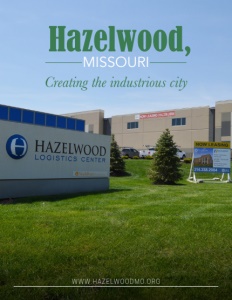Hazelwood, MO
Creating the industrious city
Business View Magazine interviews representatives from Hazelwood, MO, as part of our series on best practices of American towns and cities.
The story of Hazelwood, MO goes that it was organized in the conference rooms of the 1948 Ford plant. “The Ford facility helped build this city,” says Becky Ahlvin, Community and Economic Development Coordinator. “They came in 1946 and started building the assembly plant that became operational two years later, one year before Hazelwood became incorporated as a village,” adds Matt Zimmerman, City Manager. “How that came to be, according to the history books, is partly the result of us wanting to control our own destiny. We didn’t want other towns coming in and pillaging from the long-standing German farmers who’d settled here. We didn’t want them dictating the development plans around the Ford factory.”
The post-WW2 boom years of the 1950s and 1960s had a sizeable impact on the growth of the aviation industry in and around Hazelwood as the area became corporate headquarters to aerospace juggernaut McDonnell Douglas. The industrious city hasn’t looked back since.
“That resulted in a lot of our housing stock being built,” Zimmerman continues. “The capsule that went to the moon – that was built at the McDonnell Douglas facility right here, adjacent to Hazelwood, in unincorporated St. Louis County. Many Hazelwood residents worked on it.”
McDonnell Douglas, along with the Boeing Company and the aerospace and defense units of Rockwell International, built all the major components of the Apollo spacecraft, as well as the giant Saturn V moon rocket used on most of the manned lunar missions. “You either worked at Ford, or you worked at McDonnell Douglas,” Zimmerman quips.
From those two seeds, Hazelwood, today a town of just under 26,000 people, was able to prosper and expand into multiple industrial parks and facilities. “We’ve got a couple of redevelopment projects currently going on,” shares Ahlvin. “We’ve got Village Square, which is one of the main shopping centres in Hazelwood.” Conveniently situated at the entrance to the city, northwest of the intersection of I-270 and Lindbergh Blvd., the property was, during its heyday, the commercial heart of a quasi-downtown area for the residents of Hazelwood and North County. “It had a community pool, a grocery store, restaurants, a stationery store—everything you’d typically see back in the 1950s, before it all turned over to big box retailers,” adds Zimmerman. “Those were all right in Village Square.”
“The new owners are undertaking a pretty big redevelopment of that property,” says Ahlvin. “They’re looking at turning Village Square into a mixed-use center, leasing retail, offices, and medical—destination-type uses that should revive the area for the city. It’s an ongoing project, but they’ve already completed parking lot and other exterior renovations, and we’ll soon be seeing a major façade renovation. The City of Hazelwood has been working with the owners on a grant program to inspire entrepreneurs and activate the center with new local tenants. We’re helping small businesses with the start up capital to get their business up and running. Or, if they’re already established, we’re helping them grow their business and buildout out a new retail store at Village Square.”
Fatefully, the Village Square’s decline in popularity happened at the hand of important infrastructural changes to a neighboring highway. “In 2000, the intersection of Lindbergh Blvd. and just north of the I-270 was nothing but a series of stoplights,” Zimmerman explains. “Everybody hated it, so they fixed it by building an overpass. The problem with the overpass is that it by-passed the shopping center. You had to really want to get to Village Square, and that’s why it died.”
Fortunately, MoDOT, Missouri’s Department of Transportation, is undertaking a redevelopment project of its own that should integrate smoothly with the Village Square’s urban renewal program.“They’re reconstructing Interstate 270, which affects the intersection of 270 and Lindbergh right here in Hazelwood, by Village Square,” Ahlvin confirms. “They’ll be adding some lanes to 270. They’re also going to replace Lindbergh’s existing bi-directional overpass with two separate, one-directional overpasses.”
“They’re redeveloping the entire intersection,” Zimmerman says. “Not just reconstructing highway bridges but adding off-ramps that feed directly into and out of Village Square, onto Lindbergh, onto 270. We’ll even see new accesses on the frontage roads, which are the direct exits into the mixed-use center. We anticipate that when that gets completed in 2023, you’ll see a lot more buzz at Village Square.”
Although the City of Hazelwood had always hoped to face the future together with its long-standing partnership with Ford, the company announced the closing of its St. Louis assembly plant back in 2008, resulting in the subsequent layoff of 1,445 employees. “As you would expect, that really put a dent in our budget,” Ahlvin admits. Enter Panattoni Development—the California-based developer that cleared the former Ford Motor Co. site and rebranded the 155-acre infill property as the Aviator Business Park. “They’ll have about 10 buildings by the time they’re done,” says Ahlvin. “Some fairly major tenants in that location.”
The city is also working in collaboration with NorthPoint Development, a real estate developer based out of Riverside, MO. “They’ve got two business parks within the city—Hazelwood Logistics Center and Hazelwood TradePort,” says Ahlvin. “Those represent several million square feet of industrial warehousing, logistics-type buildings.”
“The Logistics Center had the first Amazon facility in Missouri,” adds Zimmerman. “We’re a little proud of that.” Other major corporations that call Hazelwood home include the American Red Cross, Bunzl, International Foods, Quiet Logistics, and Siligan Plastics. “Then there’s Weekends Only, which is a local furniture chain,” Ahlvin continues. “Wayfair also has a facility here.” “24/7 Wine and Liquor,” adds Zimmerman. “They’re growing into the region. I believe they’re from California.”
“They market themselves as the Amazon of wine,” Ahlvin recalls. “They’ve taken up a pretty good square footage, about 95,000,” says Zimmerman. “You can sip your wine as you’re picking up your Amazon package.” “It doesn’t quite work that way,” Ahlvin counters. “I’ve asked.”
Hazelwood also boasts a 1.3 million-square-foot outlet mall that’s being redeveloped with the help of Big Sports Properties. “It’s a public/private partnership,” says Ahlvin. “They’re hoping to turn it into what they’re calling the POWERplex—a large youth sports recreation destination. It’s going to have volleyball, beach volleyball, pickleball, basketball, baseball, and softball venues, along with several eateries and hotels that will get built up around the complex.”
While the city has been both visionary and supportive in getting these developments underway, those projects have increasingly featured three major and somewhat interconnected shortfalls: traffic, inadequate city planning, and low housing stock. “We have terrible traffic backups,” admits Zimmerman. “We have relatively little housing compared to our neighbors. We’ve got industry instead of stores. Basically, our housing stock supports the industry. We’re part of somebody else’s circle, if you get what I’m saying. Our residents go into other towns—Florissant to the north, Bridgeton and Maryland Heights to the south—to go grocery shopping, restaurant dining, or to Wal-Mart. It’s funny because you open a newspaper and read ‘Oh, Florissant is getting a (insert big-name chain store).’ Then, the following week, Bridgeton’s getting the exact same thing. We’ve had four or five chains open in both of those towns. That’s been a source of frustration. Our number-one goal set forth by the public is the grocery store. Again, we’re having trouble with that because of all the competition just beyond Hazelwood’s city limits.”
“And we’re pretty much built out,” Zimmerman continues. “There’s really no land left for housing construction. We have a few infill lots here and there. One of our challenges is to keep the housing stock up. We have a very strong code enforcement program, a rental inspection program, and an occupancy program. Anytime anyone sells and moves, or their lease is up, we go in and inspect the residence to make sure it’s up to code. We really work hard to maintain the value of our housing stock. We’ve identified a couple of areas that could be prime for redevelopment around the East side. It’s been a little slower than we would like. We’re currently working with Habitat for Humanity and the private sector to try and redevelop the properties that have been sorely neglected. There are some cute neighborhoods over there, but some really bad houses as well.”
Another critical issue still to be tackled is Hazelwood’s lack of a downtown core. “We really don’t have a discernible downtown district and I think it’s something that works against us,” says Zimmerman. “We don’t even really have a community gathering space. The closest thing we have is Howdershell Park, which is where we hold most of our community events—Harvestfest, those kinds of things. We’ve talked to Village Square about designating some of those areas as community gathering spaces, but they’re waiting to see how the development plays out.”
Despite these small setbacks in urban planning, the City of Hazelwood is unequivocally open for business. “We encourage business owners to contact us,” says Zimmerman. “We’re confident we’re able to get projects done and our success record, just in the six years that I’ve occupied this post, demonstrates that. We’ve got a dedicated economic development fund that provides about $1.6 million to business projects. That’s unique and very unusual for the St. Louis area. We also have the 8-lane, I-270 that comes right through our town. That connects you to the entire interstate network. You’re 10 minutes from I-70, 15 minutes from I-64, 20 minutes from I-44, and 25 minutes from I-55. We’ve got a Class 1 railroad, with rail spurs available for business. We’re right on the Norfolk Southern Continental line, with existing spurs into several of our industrial parks. We’ve got highway access, rail access, and we butt up against Lambert-St. Louis International Airport, so we’ve got access to trans-continental and international flights.”
With the city’s slogan being “Discover Hazelwood,” all that infrastructure makes it incredibly easy and convenient to do just that.
AT A GLANCE
WHO: Hazelwood, MO
WHAT: A city of 26,000
WHERE: St. Louis County, Missouri
WEBSITE: www.hazelwoodmo.org



